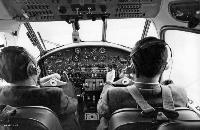Фотографии
-
Регистрационный номер: 9L-LAD, 9L-LAK Taxying in with inboard engines stopped is Sierra Leone Airways de Havilland D.H.114 Heron 9L-LAD, one of two ultimately operated by the airline. In the foreground is one of a pair of Bell 47G helicopters operated in Sierra Leone by Autair, and behind that is the Beech H18, with tricycle undercarriage, operated by De Beers from the city of Bo, 155 miles (250km) south-east of Freetown.
Самолёты на фотографии: Beechcraft Model 18 / C-45 Expeditor - США - 1937Bell H-13 Sioux / Model 47 - США - 1945De Havilland Heron / D.H.114 - Великобритания - 1950
-
The helicopter’s unique abilities were of great use in Sierra Leone, serviceable runways being comparatively few and far between. Here the author’s wife and son enjoy a local flight in one of the Bell 47Gs, with Autair’s Franz Astner at the controls.
Самолёты на фотографии: Bell H-13 Sioux / Model 47 - США - 1945
-
The author beside The Pig at Hastings Airfield, near Freetown, in 1966. The initials SLST on the forward fuselage beneath the cockpit window refer to the aircraft’s operator, the Sierra Leone Selection Trust. McAlpine Aviation at Luton, for which the author was working, had been the official UK agent for Piaggio since May 1959.
Самолёты на фотографии: Piaggio P.166 Portofino - Италия - 1957
-
Регистрационный номер: 9L-LAF [2], 5N-ADP [2], G-AWWJ [2] “The Pig” - Piaggio P.166M 9L-LAF, c/n 406, undergoing maintenance at its base at Yengema, Sierra Leone, in 1966. The unconventional gullwinged utility aircraft of pusher configuration was a development of the same company’s P.136 amphibian, the prototype P.166 making its first flight in November 1957.
Самолёты на фотографии: Piaggio P.166 Portofino - Италия - 1957
-
Регистрационный номер: 9L-LAF [2], 5N-ADP [2], G-AWWJ [2] The Pig heading south-east down the coast from Lungi Airport to Hastings for a night-stop in Freetown. In December 1968 the aircraft was put on the British civil register as G-AWWJ, but was cancelled five months later to be put on the Swiss register. It was then sold in February 1970 to a new owner in Nigeria, where it became 5N-ADP.
Самолёты на фотографии: Piaggio P.166 Portofino - Италия - 1957
-
Регистрационный номер: G-ARUJ Piaggio P.166 G-ARUJ, operated by Charrington Breweries, outside the McAlpine Aviation hangar at Luton, where the company provided maintenance services for the type. The underrated P.166 offered superb short-field performance, being able to take off with a full load of passengers and fuel from a 600 yd (550 m) grass strip.
Самолёты на фотографии: Piaggio P.166 Portofino - Италия - 1957
-
Регистрационный номер: G-APWY The office - the cockpit of P.166 G-APWY, operated by McAlpine on behalf of Marconi’s aeronautical division. Contemporary flight reports on the type are unanimously positive, James Hay Stevens describing it in a May 1959 article in Flight as “lively but docile”, another report referring to it as “handsome and highly efficient”.
Самолёты на фотографии: Piaggio P.166 Portofino - Италия - 1957
Статьи
- -
- ??? - Gone Fishin'!
- A.Tincopa - Wings over Peru
- B.Dunnell - Falklands confidential
- D.Gordon, I.Bott - Days of Thunder
- E.Wild - West Africa Wins Again ... or pigs can fly
- G.Alegi - ... a 350 lb Mystery
- J.Picarella, C.Koberg - Sunken treasure?
- J.Pote - A Close Shave at Wellington
- M.Garden - Oscar Garden the Sundowner of the Skies
- N.Stroud - The Last of the Many
- P.Davidson - Off the Beaten Track...
- P.Jarrett - Pioneering the Fighter (2)
- P.Vabre - Any port in a storm ... From Qantas Empire Airways
- R.Tisdale, A.Vercamer - Before & After






